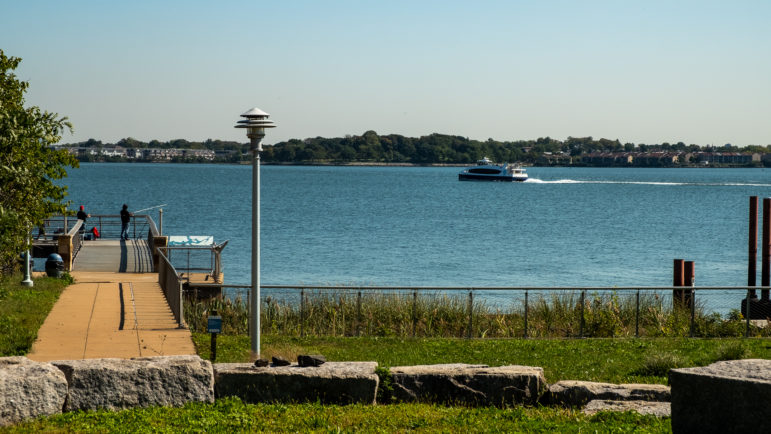City officials are reaching out to the private sector to help shift some of the delivery of commercial goods away from New York City’s busy streets and onto its waterways.

Adi Talwar
View of the East River from Hunts Point Landing in The Bronx.A citywide effort to shift the delivery of commercial goods away from polluting trucks and onto New York City’s harbors made some strides Wednesday.
The New York City Department of Transportation (NYC DOT) and the Economic Development Corporation (NYC EDC) launched a call for maritime companies to give feedback on how to support the movement of cargo through New York City’s harbors.
The initiative is part of a larger program called “Blue Highways,” launched under former Mayor Bill de Blasio to increase private investments in marine vessels to transport goods into and around the city.
Despite being a city of islands, New York’s waterways carry less than 10 percent of freight, according to NYC DOT. But city officials say the underutilization of this massive resource is about to change.
“Reactivating our waterways for the movement of goods can help reduce the City’s reliance on large trucks, cutting down on congestion and emissions,” said NYC DOT Commissioner Ydanis Rodriguez in a press release.
Cortney Koenig Worrall, president and CEO of Waterfront Alliance, said the initiative is “moving in the right direction.”
“This is an area that hasn’t actually reached its full vision,” Koenig Worrall told City Limits. “There’s so many more things that can be done through our waterways to help activate options for reducing traffic and congestion and to reduce carbon emissions and planned vehicle pollution. So it’s a great opportunity.”
Close to 90 percent of the city’s goods are moved into and around the city by truck, according to the DOT. Kendra Hems, president of the Trucking Association of New York, is supportive of the city’s waterway program.
“E-commerce just took off during the pandemic, and it hasn’t slowed down. So we’re seeing a lot more truck traffic as a result of the demand for same day, next day delivery. And it’s not sustainable,” said Hems. “So there has to be partnerships and collaboration amongst all modes to ensure that we are moving as efficiently as we can.”
Hems believes that moving more cargo to the waterways won’t have a direct impact on the trucking industry, either. The bigger shift, she points out, will be in the reduction of larger long distance transportation vehicles, which could potentially be replaced by shipments via waterways.
“But you’re still going to see some smaller box trucks that are needed for that last mile delivery once [a product] comes in,” Hems explained.
“So I don’t think we’re going to see a significant displacement as it relates to jobs, there’s still going to be a need, we’re just going to hopefully see some shifts in making the overall movement of freight in the city much more efficient,” she added.








